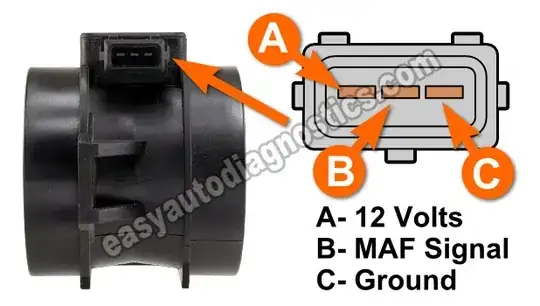I've just bought this MAF sensor for the injection setup I'm going to build, and first I was struggling to figure out how to connect it. It's used for several BMW cars.(E38,E39,Z3) On the connector it says "3 2 1" and the letters Sn and Ag. No idea why that is printed there.
I first thought i found out how to connect it. From left to right I connected respectively 12V, ground, and signal. That was wrong. I got a static 'signal' on the ground pin of 2.7V which didn't change when air blew past it.
I later found the right pinout here. That pinout is different; 12V, signal, and ground from left to right. So i formerly had the MAF hooked up with signal pulled to ground, while measuring the ground pin.
When hooked up right and 5V applied to it, it gave a steady 680mV signal while no air blew past it, and 70mA of supply current was consumed. When 12V applied to it, it gave a varying signal between 90-200mV, while no air blew past it, and 80mA of supply current was consumed. In both cases, signal voltage increased fairly when I blew air past it.
I'm in doubt about the varying signal at 12V. It may have gone bad because I wired it wrong first, explaining the varying signal when I increased supply to 12V. Is it normal a MAF sensor's signal isn't that steady when there is no air flow, or does this MAF sensor have a supply voltage of 5V? That would be uncommon I believe, but the signal seems steady and in the right range at that voltage.
I can't really test it, because it's a individual sensor that I bought. I don't have the engine that I can use to blow sufficient air through it to test steadiness during airflow. Thanks for your help guys.


